PUBH6001 Assessment 2: Analysis of Cancer Prevention Policy
VerifiedAdded on 2022/09/05
|12
|3520
|25
Essay
AI Summary
This policy analysis essay critically evaluates the National Cancer Prevention Policy in Australia. The essay examines the problem of cancer, the policy's context, and the stakeholders involved, including the government and healthcare providers. It explores the policy's frame of reference, which emphasizes cancer prevention through addressing risk factors like tobacco, UV radiation, obesity, and alcohol. The analysis delves into the policy process, including its goals, targets, and strategies, and assesses its effectiveness in terms of program implementation and impact on cancer screening and prevention. The essay highlights the policy's solutions, such as promoting awareness, early detection, and treatment, while also acknowledging areas for potential improvement, such as addressing genetic factors. The essay concludes by assessing the policy's overall impact and its role in improving cancer outcomes in Australia.
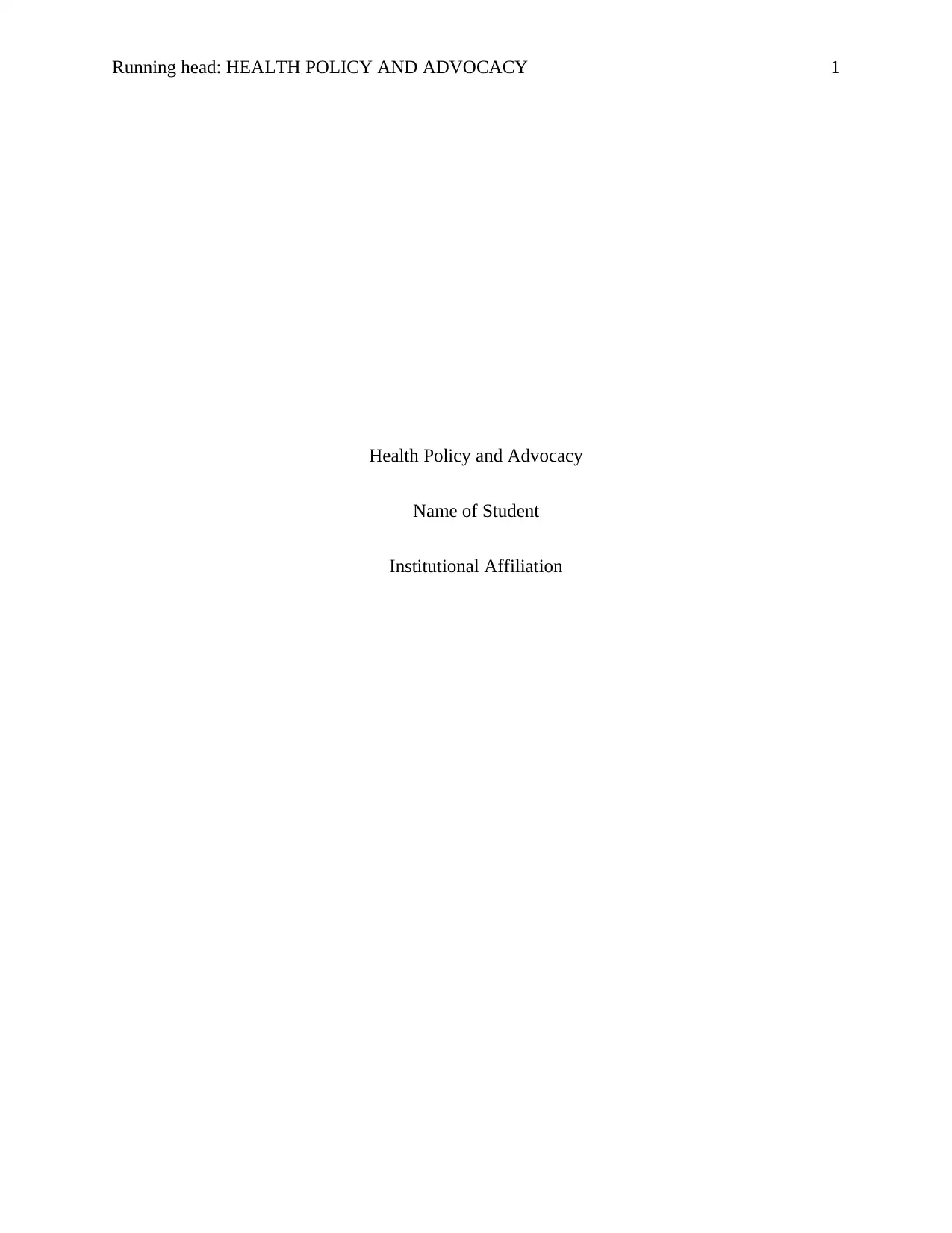
Running head: HEALTH POLICY AND ADVOCACY 1
Health Policy and Advocacy
Name of Student
Institutional Affiliation
Health Policy and Advocacy
Name of Student
Institutional Affiliation
Paraphrase This Document
Need a fresh take? Get an instant paraphrase of this document with our AI Paraphraser
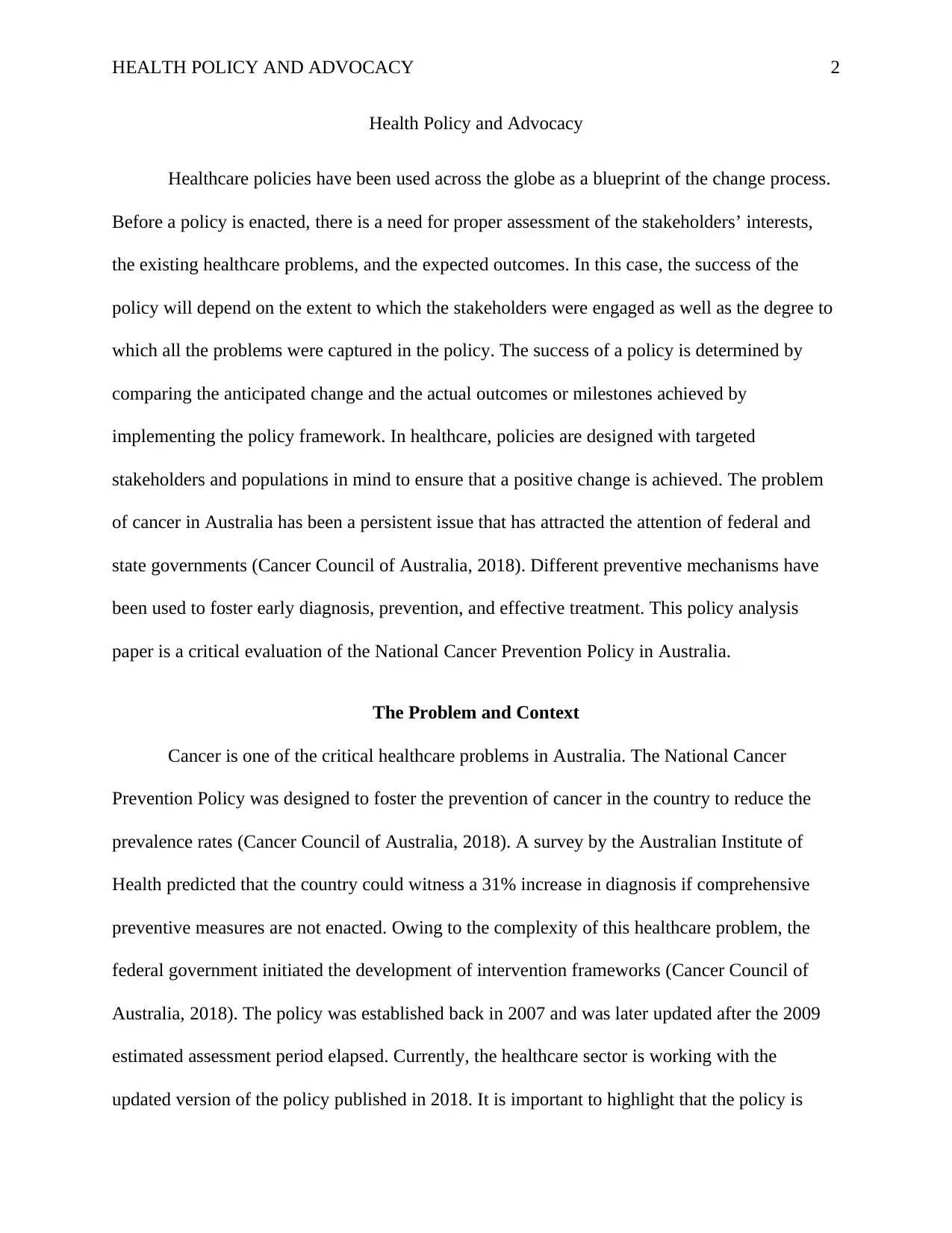
HEALTH POLICY AND ADVOCACY 2
Health Policy and Advocacy
Healthcare policies have been used across the globe as a blueprint of the change process.
Before a policy is enacted, there is a need for proper assessment of the stakeholders’ interests,
the existing healthcare problems, and the expected outcomes. In this case, the success of the
policy will depend on the extent to which the stakeholders were engaged as well as the degree to
which all the problems were captured in the policy. The success of a policy is determined by
comparing the anticipated change and the actual outcomes or milestones achieved by
implementing the policy framework. In healthcare, policies are designed with targeted
stakeholders and populations in mind to ensure that a positive change is achieved. The problem
of cancer in Australia has been a persistent issue that has attracted the attention of federal and
state governments (Cancer Council of Australia, 2018). Different preventive mechanisms have
been used to foster early diagnosis, prevention, and effective treatment. This policy analysis
paper is a critical evaluation of the National Cancer Prevention Policy in Australia.
The Problem and Context
Cancer is one of the critical healthcare problems in Australia. The National Cancer
Prevention Policy was designed to foster the prevention of cancer in the country to reduce the
prevalence rates (Cancer Council of Australia, 2018). A survey by the Australian Institute of
Health predicted that the country could witness a 31% increase in diagnosis if comprehensive
preventive measures are not enacted. Owing to the complexity of this healthcare problem, the
federal government initiated the development of intervention frameworks (Cancer Council of
Australia, 2018). The policy was established back in 2007 and was later updated after the 2009
estimated assessment period elapsed. Currently, the healthcare sector is working with the
updated version of the policy published in 2018. It is important to highlight that the policy is
Health Policy and Advocacy
Healthcare policies have been used across the globe as a blueprint of the change process.
Before a policy is enacted, there is a need for proper assessment of the stakeholders’ interests,
the existing healthcare problems, and the expected outcomes. In this case, the success of the
policy will depend on the extent to which the stakeholders were engaged as well as the degree to
which all the problems were captured in the policy. The success of a policy is determined by
comparing the anticipated change and the actual outcomes or milestones achieved by
implementing the policy framework. In healthcare, policies are designed with targeted
stakeholders and populations in mind to ensure that a positive change is achieved. The problem
of cancer in Australia has been a persistent issue that has attracted the attention of federal and
state governments (Cancer Council of Australia, 2018). Different preventive mechanisms have
been used to foster early diagnosis, prevention, and effective treatment. This policy analysis
paper is a critical evaluation of the National Cancer Prevention Policy in Australia.
The Problem and Context
Cancer is one of the critical healthcare problems in Australia. The National Cancer
Prevention Policy was designed to foster the prevention of cancer in the country to reduce the
prevalence rates (Cancer Council of Australia, 2018). A survey by the Australian Institute of
Health predicted that the country could witness a 31% increase in diagnosis if comprehensive
preventive measures are not enacted. Owing to the complexity of this healthcare problem, the
federal government initiated the development of intervention frameworks (Cancer Council of
Australia, 2018). The policy was established back in 2007 and was later updated after the 2009
estimated assessment period elapsed. Currently, the healthcare sector is working with the
updated version of the policy published in 2018. It is important to highlight that the policy is
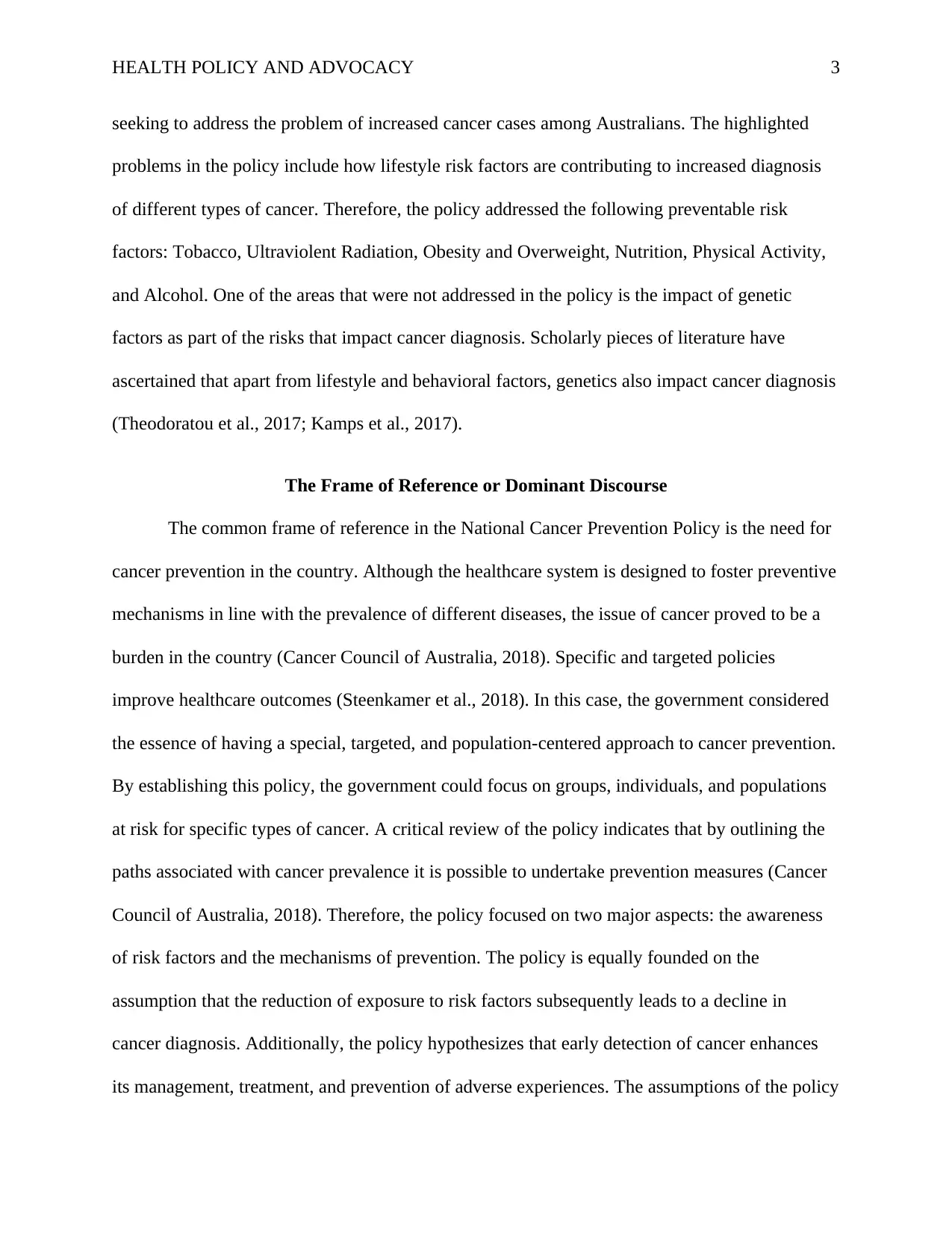
HEALTH POLICY AND ADVOCACY 3
seeking to address the problem of increased cancer cases among Australians. The highlighted
problems in the policy include how lifestyle risk factors are contributing to increased diagnosis
of different types of cancer. Therefore, the policy addressed the following preventable risk
factors: Tobacco, Ultraviolent Radiation, Obesity and Overweight, Nutrition, Physical Activity,
and Alcohol. One of the areas that were not addressed in the policy is the impact of genetic
factors as part of the risks that impact cancer diagnosis. Scholarly pieces of literature have
ascertained that apart from lifestyle and behavioral factors, genetics also impact cancer diagnosis
(Theodoratou et al., 2017; Kamps et al., 2017).
The Frame of Reference or Dominant Discourse
The common frame of reference in the National Cancer Prevention Policy is the need for
cancer prevention in the country. Although the healthcare system is designed to foster preventive
mechanisms in line with the prevalence of different diseases, the issue of cancer proved to be a
burden in the country (Cancer Council of Australia, 2018). Specific and targeted policies
improve healthcare outcomes (Steenkamer et al., 2018). In this case, the government considered
the essence of having a special, targeted, and population-centered approach to cancer prevention.
By establishing this policy, the government could focus on groups, individuals, and populations
at risk for specific types of cancer. A critical review of the policy indicates that by outlining the
paths associated with cancer prevalence it is possible to undertake prevention measures (Cancer
Council of Australia, 2018). Therefore, the policy focused on two major aspects: the awareness
of risk factors and the mechanisms of prevention. The policy is equally founded on the
assumption that the reduction of exposure to risk factors subsequently leads to a decline in
cancer diagnosis. Additionally, the policy hypothesizes that early detection of cancer enhances
its management, treatment, and prevention of adverse experiences. The assumptions of the policy
seeking to address the problem of increased cancer cases among Australians. The highlighted
problems in the policy include how lifestyle risk factors are contributing to increased diagnosis
of different types of cancer. Therefore, the policy addressed the following preventable risk
factors: Tobacco, Ultraviolent Radiation, Obesity and Overweight, Nutrition, Physical Activity,
and Alcohol. One of the areas that were not addressed in the policy is the impact of genetic
factors as part of the risks that impact cancer diagnosis. Scholarly pieces of literature have
ascertained that apart from lifestyle and behavioral factors, genetics also impact cancer diagnosis
(Theodoratou et al., 2017; Kamps et al., 2017).
The Frame of Reference or Dominant Discourse
The common frame of reference in the National Cancer Prevention Policy is the need for
cancer prevention in the country. Although the healthcare system is designed to foster preventive
mechanisms in line with the prevalence of different diseases, the issue of cancer proved to be a
burden in the country (Cancer Council of Australia, 2018). Specific and targeted policies
improve healthcare outcomes (Steenkamer et al., 2018). In this case, the government considered
the essence of having a special, targeted, and population-centered approach to cancer prevention.
By establishing this policy, the government could focus on groups, individuals, and populations
at risk for specific types of cancer. A critical review of the policy indicates that by outlining the
paths associated with cancer prevalence it is possible to undertake prevention measures (Cancer
Council of Australia, 2018). Therefore, the policy focused on two major aspects: the awareness
of risk factors and the mechanisms of prevention. The policy is equally founded on the
assumption that the reduction of exposure to risk factors subsequently leads to a decline in
cancer diagnosis. Additionally, the policy hypothesizes that early detection of cancer enhances
its management, treatment, and prevention of adverse experiences. The assumptions of the policy
⊘ This is a preview!⊘
Do you want full access?
Subscribe today to unlock all pages.

Trusted by 1+ million students worldwide

HEALTH POLICY AND ADVOCACY 4
are extensively backed in clinical-based evidence and scholarly literature (Heitzer et al., 2017;
Uttley et al., 2016).
Targets, Stakeholders, and their Representation
National Cancer Prevention Policy targets individuals who are at a high risk of being
diagnosed with cancer. However, to achieve this paramount objective, the policy outlined the key
stakeholders in the healthcare sector and beyond who contribute to the achievement of the
outlined objectives. The Cancer Council resorted to building a strong collaboration with the
ministry of health because of the increasing evidence of the impact of partnership in meeting
healthcare goals. The policy incorporated the Global Strategy on Diet, Physical Activity, and
Health designed by the WHO as part of the prevention mechanism (Cancer Council of Australia,
2018). In this global strategy, the institutions under the ministry of health at the federal and state
level formed part of the key stakeholders. Healthcare coordinators, ministries, departments, and
institutions across territories, states, and local governments are considered as key stakeholders in
the implementation of the policy. The healthcare system in Australia has thrived from the
advantages of coordinated and institutionalized implementation between government and non-
governmental agencies (Baugh et al., 2018). The healthcare workforce across different
specializations for part of the primary implementors of policy initiatives and activities. The
synergistic effect of the healthcare workforce has been considered as the backbone of the
preventive interventions for a specific population in Australia affected by the cancer menace.
It is essential to highlight how the policy defined and outlined the subjects in the policy.
In the policy, specific risk factors have been defined, which in turn mimic the representation of
the targeted subjects. The first risk factor identified in the policy is the use of tobacco, which is a
behavioral factor associated with a significant number of cancer diagnoses. Ultraviolet radiation
are extensively backed in clinical-based evidence and scholarly literature (Heitzer et al., 2017;
Uttley et al., 2016).
Targets, Stakeholders, and their Representation
National Cancer Prevention Policy targets individuals who are at a high risk of being
diagnosed with cancer. However, to achieve this paramount objective, the policy outlined the key
stakeholders in the healthcare sector and beyond who contribute to the achievement of the
outlined objectives. The Cancer Council resorted to building a strong collaboration with the
ministry of health because of the increasing evidence of the impact of partnership in meeting
healthcare goals. The policy incorporated the Global Strategy on Diet, Physical Activity, and
Health designed by the WHO as part of the prevention mechanism (Cancer Council of Australia,
2018). In this global strategy, the institutions under the ministry of health at the federal and state
level formed part of the key stakeholders. Healthcare coordinators, ministries, departments, and
institutions across territories, states, and local governments are considered as key stakeholders in
the implementation of the policy. The healthcare system in Australia has thrived from the
advantages of coordinated and institutionalized implementation between government and non-
governmental agencies (Baugh et al., 2018). The healthcare workforce across different
specializations for part of the primary implementors of policy initiatives and activities. The
synergistic effect of the healthcare workforce has been considered as the backbone of the
preventive interventions for a specific population in Australia affected by the cancer menace.
It is essential to highlight how the policy defined and outlined the subjects in the policy.
In the policy, specific risk factors have been defined, which in turn mimic the representation of
the targeted subjects. The first risk factor identified in the policy is the use of tobacco, which is a
behavioral factor associated with a significant number of cancer diagnoses. Ultraviolet radiation
Paraphrase This Document
Need a fresh take? Get an instant paraphrase of this document with our AI Paraphraser

HEALTH POLICY AND ADVOCACY 5
is also outlined as another risk factor for cancer diagnosis (Cancer Council of Australia, 2018).
The other three subjects defined in the policy include obesity and overweight, nutrition, physical
activity, and alcohol use. Scholars have shown that these factors present a higher risk for cancer
diagnosis, which ascertains why the policy focused on these areas to justify preventive
frameworks and interventions (Wu et al., 2018; Chao et al., 2019). Additionally, the policy has
identified different social groups based on the risk factors as well as the different types of
cancers. Breast, Lung, Cervical, Bowel, Melanoma, and Prostate cancers were included in the
policy as the key types that could be prevented through early and regular screening. Research
evaluations have indicated that breast, cervical, bowel, and prostate cancer could be prevented
through early screening and diagnosis (Musa et al., 2017). The policy defined how risk factors
are associated with the prevalence of diagnosis. Although this does not awaken moral questions,
it provides baseline the avenue for judgment regarding the impact of specific behaviors and
cancer diagnosis.
Policy Process
The Cancer Council of Australia initiated the policy establishment process where other
stakeholders were incorporated. The justification for the development of the policy was the
increasing evidence on the link between risk factors, early diagnosis, and cancer prevention.
CCA, formerly the Australian Cancer Society, therefore worked with the federal and territorial
governments to embed specific programs targeting behavioral factors associated with healthcare
problems into a unified framework to tackle the cancer menace (Cancer Council of Australia,
2018). The first step was a series of workshops that brought together experts from all states. The
outcome of these workshops, in terms of recommendations and evidence analysis, culminated in
the establishment of the first version of the National Cancer Prevention Policy for Australia. In
is also outlined as another risk factor for cancer diagnosis (Cancer Council of Australia, 2018).
The other three subjects defined in the policy include obesity and overweight, nutrition, physical
activity, and alcohol use. Scholars have shown that these factors present a higher risk for cancer
diagnosis, which ascertains why the policy focused on these areas to justify preventive
frameworks and interventions (Wu et al., 2018; Chao et al., 2019). Additionally, the policy has
identified different social groups based on the risk factors as well as the different types of
cancers. Breast, Lung, Cervical, Bowel, Melanoma, and Prostate cancers were included in the
policy as the key types that could be prevented through early and regular screening. Research
evaluations have indicated that breast, cervical, bowel, and prostate cancer could be prevented
through early screening and diagnosis (Musa et al., 2017). The policy defined how risk factors
are associated with the prevalence of diagnosis. Although this does not awaken moral questions,
it provides baseline the avenue for judgment regarding the impact of specific behaviors and
cancer diagnosis.
Policy Process
The Cancer Council of Australia initiated the policy establishment process where other
stakeholders were incorporated. The justification for the development of the policy was the
increasing evidence on the link between risk factors, early diagnosis, and cancer prevention.
CCA, formerly the Australian Cancer Society, therefore worked with the federal and territorial
governments to embed specific programs targeting behavioral factors associated with healthcare
problems into a unified framework to tackle the cancer menace (Cancer Council of Australia,
2018). The first step was a series of workshops that brought together experts from all states. The
outcome of these workshops, in terms of recommendations and evidence analysis, culminated in
the establishment of the first version of the National Cancer Prevention Policy for Australia. In
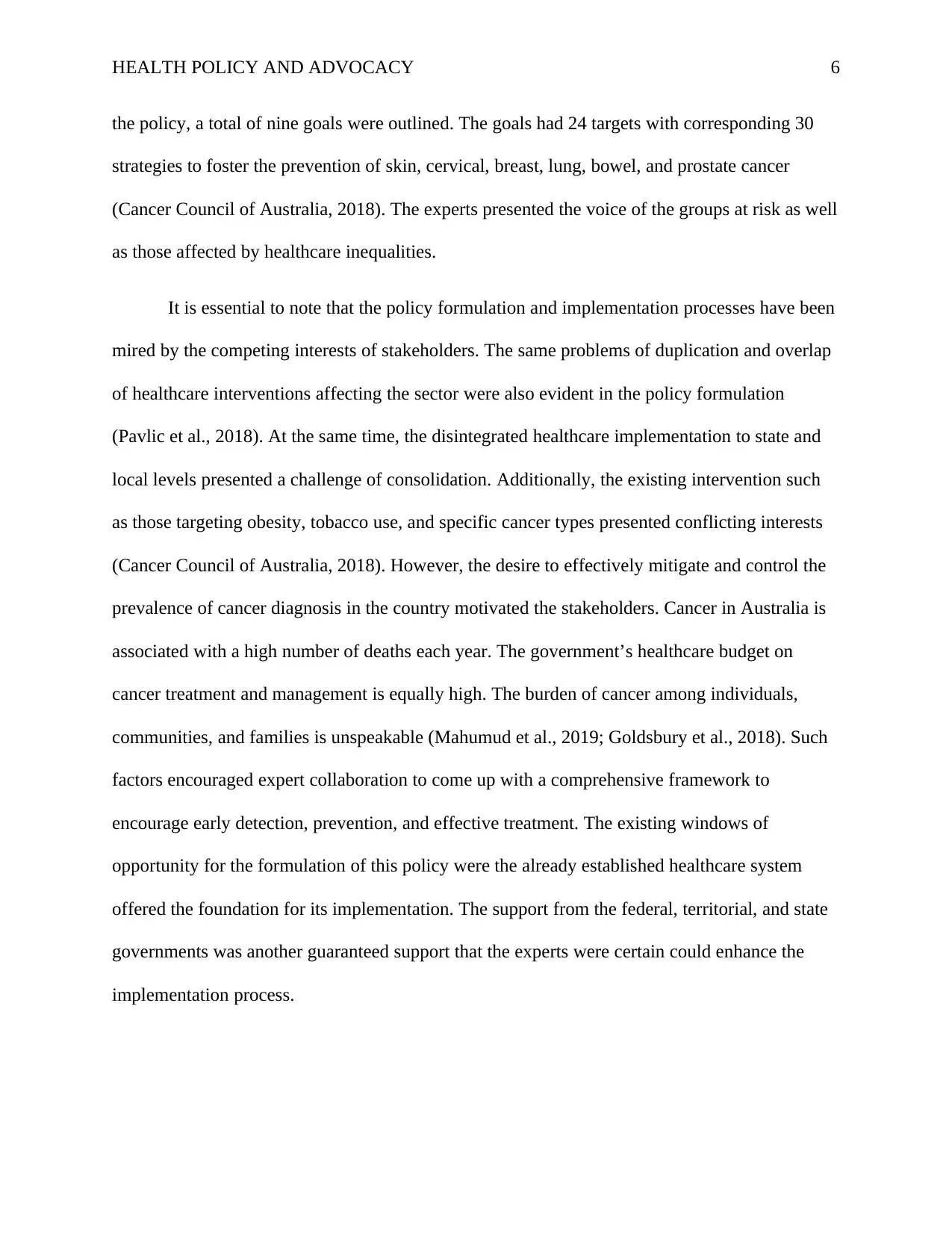
HEALTH POLICY AND ADVOCACY 6
the policy, a total of nine goals were outlined. The goals had 24 targets with corresponding 30
strategies to foster the prevention of skin, cervical, breast, lung, bowel, and prostate cancer
(Cancer Council of Australia, 2018). The experts presented the voice of the groups at risk as well
as those affected by healthcare inequalities.
It is essential to note that the policy formulation and implementation processes have been
mired by the competing interests of stakeholders. The same problems of duplication and overlap
of healthcare interventions affecting the sector were also evident in the policy formulation
(Pavlic et al., 2018). At the same time, the disintegrated healthcare implementation to state and
local levels presented a challenge of consolidation. Additionally, the existing intervention such
as those targeting obesity, tobacco use, and specific cancer types presented conflicting interests
(Cancer Council of Australia, 2018). However, the desire to effectively mitigate and control the
prevalence of cancer diagnosis in the country motivated the stakeholders. Cancer in Australia is
associated with a high number of deaths each year. The government’s healthcare budget on
cancer treatment and management is equally high. The burden of cancer among individuals,
communities, and families is unspeakable (Mahumud et al., 2019; Goldsbury et al., 2018). Such
factors encouraged expert collaboration to come up with a comprehensive framework to
encourage early detection, prevention, and effective treatment. The existing windows of
opportunity for the formulation of this policy were the already established healthcare system
offered the foundation for its implementation. The support from the federal, territorial, and state
governments was another guaranteed support that the experts were certain could enhance the
implementation process.
the policy, a total of nine goals were outlined. The goals had 24 targets with corresponding 30
strategies to foster the prevention of skin, cervical, breast, lung, bowel, and prostate cancer
(Cancer Council of Australia, 2018). The experts presented the voice of the groups at risk as well
as those affected by healthcare inequalities.
It is essential to note that the policy formulation and implementation processes have been
mired by the competing interests of stakeholders. The same problems of duplication and overlap
of healthcare interventions affecting the sector were also evident in the policy formulation
(Pavlic et al., 2018). At the same time, the disintegrated healthcare implementation to state and
local levels presented a challenge of consolidation. Additionally, the existing intervention such
as those targeting obesity, tobacco use, and specific cancer types presented conflicting interests
(Cancer Council of Australia, 2018). However, the desire to effectively mitigate and control the
prevalence of cancer diagnosis in the country motivated the stakeholders. Cancer in Australia is
associated with a high number of deaths each year. The government’s healthcare budget on
cancer treatment and management is equally high. The burden of cancer among individuals,
communities, and families is unspeakable (Mahumud et al., 2019; Goldsbury et al., 2018). Such
factors encouraged expert collaboration to come up with a comprehensive framework to
encourage early detection, prevention, and effective treatment. The existing windows of
opportunity for the formulation of this policy were the already established healthcare system
offered the foundation for its implementation. The support from the federal, territorial, and state
governments was another guaranteed support that the experts were certain could enhance the
implementation process.
⊘ This is a preview!⊘
Do you want full access?
Subscribe today to unlock all pages.

Trusted by 1+ million students worldwide

HEALTH POLICY AND ADVOCACY 7
Policy Solutions
The policy presented several interventions called down to nine key goals in lien with the
prevalence of cancer in Australia. The success of a healthcare policy depends on the extent to
which the proposed interventions, solutions, and strategies are focused on both the short-term
and long-term milestones (Barg et al., 2017; Hiebert et al., 2018). So far, the existing analysis
has not identified any critical alternative measures or ethical and social implications that were
overlooked in the policy. Such a scenario has been supported by the comprehensive nature of the
proposed interventions and the periodic improvement of the policy since its inception. The
primary prevention measures and solutions addressed the issue of tobacco, alcohol use, obesity,
and physical activity by strengthening awareness, control measures, and self-care (Cancer
Council of Australia, 2018). The population-based screening and early interventions targeted
breast, cervical, prostate, bowel, skin, and lung cancer. The policy, therefore, outlined how
healthcare stakeholders could develop and demonstrate and subsequently produce evidence-
based guidelines for prevention and control. The policy, therefore, advocated for improved
diagnostic skills, supporting early detection, and development of education initiatives.
Additionally, it described how immunization, regular screening, and effective treatment could
foster an all-inclusive, unified, and patient-centered changes in managing cancer in the country
(Cancer Council of Australia, 2018). On treatment, the policy described how the improvement of
guidelines, multidisciplinary care, palliative care, and psychosocial support could enhance
patient outcomes. Other dimensions addressed as part of the solution included the need for
equitable care, consumer collaboration, continuous research, and resource mobilization.
Policy Solutions
The policy presented several interventions called down to nine key goals in lien with the
prevalence of cancer in Australia. The success of a healthcare policy depends on the extent to
which the proposed interventions, solutions, and strategies are focused on both the short-term
and long-term milestones (Barg et al., 2017; Hiebert et al., 2018). So far, the existing analysis
has not identified any critical alternative measures or ethical and social implications that were
overlooked in the policy. Such a scenario has been supported by the comprehensive nature of the
proposed interventions and the periodic improvement of the policy since its inception. The
primary prevention measures and solutions addressed the issue of tobacco, alcohol use, obesity,
and physical activity by strengthening awareness, control measures, and self-care (Cancer
Council of Australia, 2018). The population-based screening and early interventions targeted
breast, cervical, prostate, bowel, skin, and lung cancer. The policy, therefore, outlined how
healthcare stakeholders could develop and demonstrate and subsequently produce evidence-
based guidelines for prevention and control. The policy, therefore, advocated for improved
diagnostic skills, supporting early detection, and development of education initiatives.
Additionally, it described how immunization, regular screening, and effective treatment could
foster an all-inclusive, unified, and patient-centered changes in managing cancer in the country
(Cancer Council of Australia, 2018). On treatment, the policy described how the improvement of
guidelines, multidisciplinary care, palliative care, and psychosocial support could enhance
patient outcomes. Other dimensions addressed as part of the solution included the need for
equitable care, consumer collaboration, continuous research, and resource mobilization.
Paraphrase This Document
Need a fresh take? Get an instant paraphrase of this document with our AI Paraphraser

HEALTH POLICY AND ADVOCACY 8
Effectiveness
The implementation of the policy has been effective over the last decade. The
implementation has been effective because there are currently programs at the national and local
levels that are tailored to meet the objectives of the policy (Department of Health, 2019). Local
and regional facilities have been equipped with resources and well as skilled personnel to support
early screening and detection of different types of cancer. At the same time, the number of
women under the regular screening program, for example after every two years for breast cancer,
has increased.
Moreover, there has been an improvement in prevention, diagnostic, and treatment
measures for cancer patients and groups at risk (Department of Health, 2019). The number of
Australians being screened for prostate, cervical, bowel, lung, and breast cancers has increased
over the past few years. Through prompt screening, it has been easy to treat and prevent cancer
in the country (Doubeni et al., 2018). Additionally, the number of cancer prevention campaigns
specific for each targeted group has increased in the country. The projected increase rate in the
number of positively diagnosed cases before the policy was implemented has declined. In this
case, it is prudent to ascertain the role of behavioral change in reducing exposure to risk factors
(Department of Health, 2019). Furthermore, through the updated version of the policy, other
sensitive concerns such as the health status of the minority, marginalized, and special groups
have enhanced the multidimensional approach to cancer prevention in the country. Recent
studies have acknowledged that Australia has made significant milestones in preventing,
diagnosing, and treating cancer over the past decade (Department of Health, 2019).
Effectiveness
The implementation of the policy has been effective over the last decade. The
implementation has been effective because there are currently programs at the national and local
levels that are tailored to meet the objectives of the policy (Department of Health, 2019). Local
and regional facilities have been equipped with resources and well as skilled personnel to support
early screening and detection of different types of cancer. At the same time, the number of
women under the regular screening program, for example after every two years for breast cancer,
has increased.
Moreover, there has been an improvement in prevention, diagnostic, and treatment
measures for cancer patients and groups at risk (Department of Health, 2019). The number of
Australians being screened for prostate, cervical, bowel, lung, and breast cancers has increased
over the past few years. Through prompt screening, it has been easy to treat and prevent cancer
in the country (Doubeni et al., 2018). Additionally, the number of cancer prevention campaigns
specific for each targeted group has increased in the country. The projected increase rate in the
number of positively diagnosed cases before the policy was implemented has declined. In this
case, it is prudent to ascertain the role of behavioral change in reducing exposure to risk factors
(Department of Health, 2019). Furthermore, through the updated version of the policy, other
sensitive concerns such as the health status of the minority, marginalized, and special groups
have enhanced the multidimensional approach to cancer prevention in the country. Recent
studies have acknowledged that Australia has made significant milestones in preventing,
diagnosing, and treating cancer over the past decade (Department of Health, 2019).
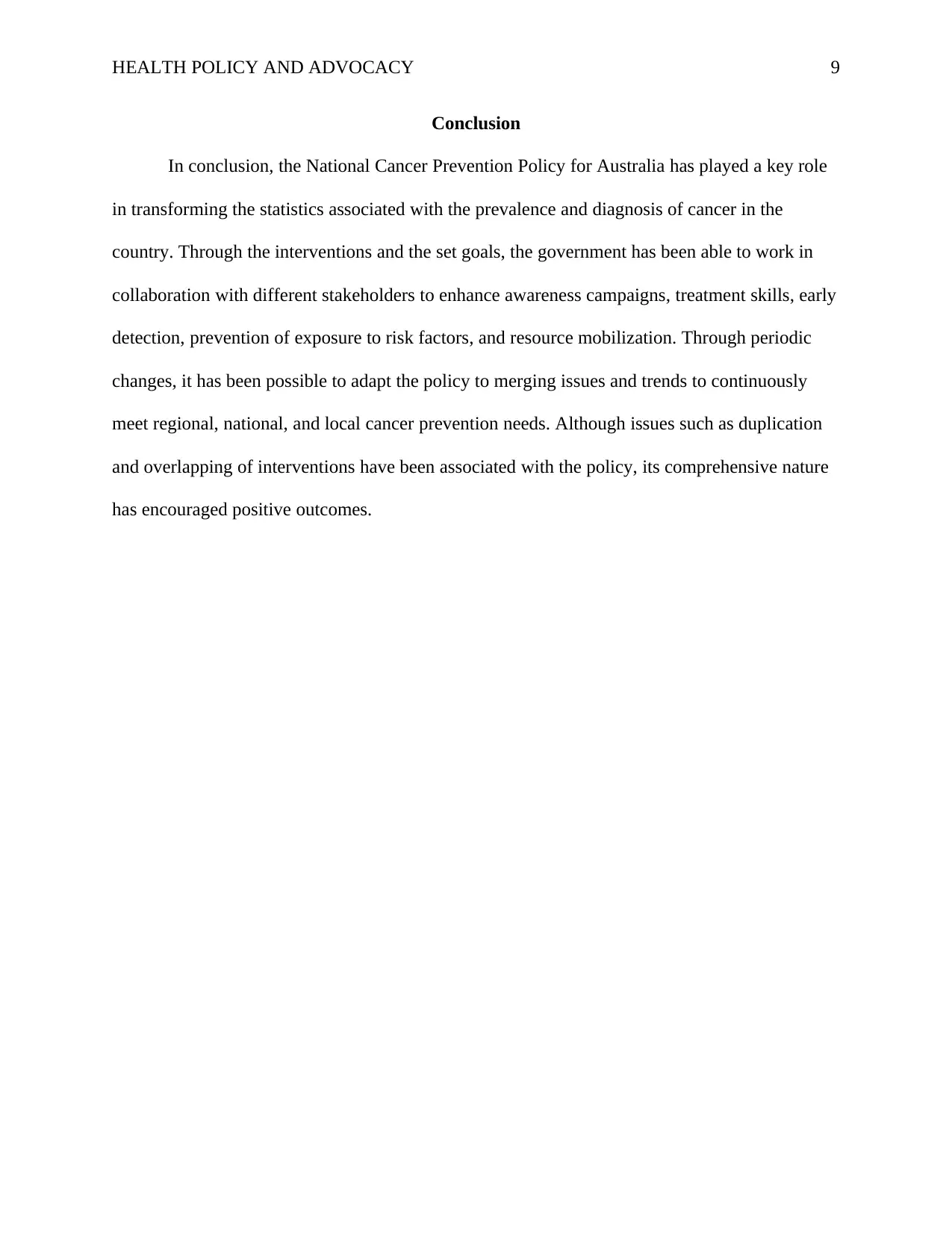
HEALTH POLICY AND ADVOCACY 9
Conclusion
In conclusion, the National Cancer Prevention Policy for Australia has played a key role
in transforming the statistics associated with the prevalence and diagnosis of cancer in the
country. Through the interventions and the set goals, the government has been able to work in
collaboration with different stakeholders to enhance awareness campaigns, treatment skills, early
detection, prevention of exposure to risk factors, and resource mobilization. Through periodic
changes, it has been possible to adapt the policy to merging issues and trends to continuously
meet regional, national, and local cancer prevention needs. Although issues such as duplication
and overlapping of interventions have been associated with the policy, its comprehensive nature
has encouraged positive outcomes.
Conclusion
In conclusion, the National Cancer Prevention Policy for Australia has played a key role
in transforming the statistics associated with the prevalence and diagnosis of cancer in the
country. Through the interventions and the set goals, the government has been able to work in
collaboration with different stakeholders to enhance awareness campaigns, treatment skills, early
detection, prevention of exposure to risk factors, and resource mobilization. Through periodic
changes, it has been possible to adapt the policy to merging issues and trends to continuously
meet regional, national, and local cancer prevention needs. Although issues such as duplication
and overlapping of interventions have been associated with the policy, its comprehensive nature
has encouraged positive outcomes.
⊘ This is a preview!⊘
Do you want full access?
Subscribe today to unlock all pages.

Trusted by 1+ million students worldwide
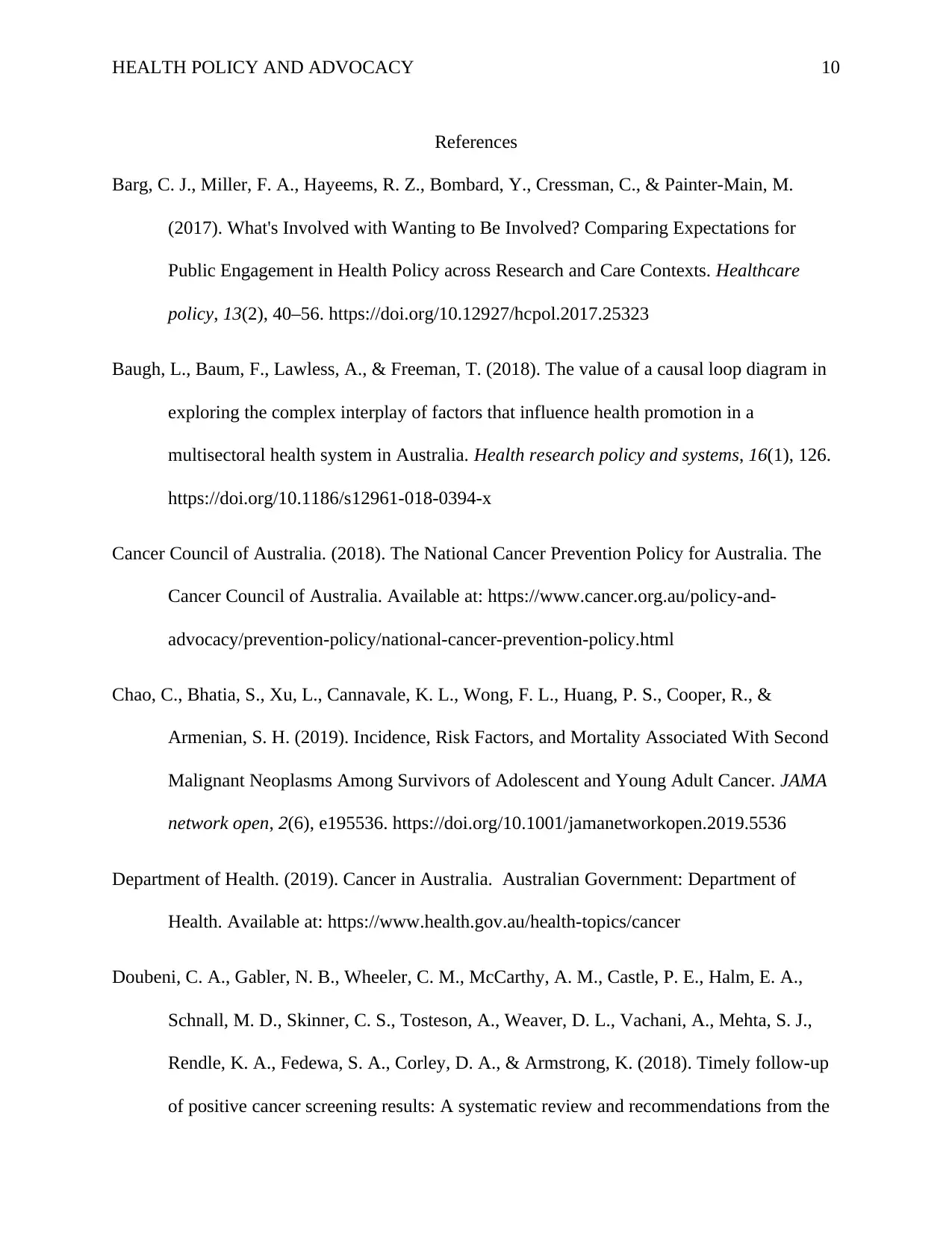
HEALTH POLICY AND ADVOCACY 10
References
Barg, C. J., Miller, F. A., Hayeems, R. Z., Bombard, Y., Cressman, C., & Painter-Main, M.
(2017). What's Involved with Wanting to Be Involved? Comparing Expectations for
Public Engagement in Health Policy across Research and Care Contexts. Healthcare
policy, 13(2), 40–56. https://doi.org/10.12927/hcpol.2017.25323
Baugh, L., Baum, F., Lawless, A., & Freeman, T. (2018). The value of a causal loop diagram in
exploring the complex interplay of factors that influence health promotion in a
multisectoral health system in Australia. Health research policy and systems, 16(1), 126.
https://doi.org/10.1186/s12961-018-0394-x
Cancer Council of Australia. (2018). The National Cancer Prevention Policy for Australia. The
Cancer Council of Australia. Available at: https://www.cancer.org.au/policy-and-
advocacy/prevention-policy/national-cancer-prevention-policy.html
Chao, C., Bhatia, S., Xu, L., Cannavale, K. L., Wong, F. L., Huang, P. S., Cooper, R., &
Armenian, S. H. (2019). Incidence, Risk Factors, and Mortality Associated With Second
Malignant Neoplasms Among Survivors of Adolescent and Young Adult Cancer. JAMA
network open, 2(6), e195536. https://doi.org/10.1001/jamanetworkopen.2019.5536
Department of Health. (2019). Cancer in Australia. Australian Government: Department of
Health. Available at: https://www.health.gov.au/health-topics/cancer
Doubeni, C. A., Gabler, N. B., Wheeler, C. M., McCarthy, A. M., Castle, P. E., Halm, E. A.,
Schnall, M. D., Skinner, C. S., Tosteson, A., Weaver, D. L., Vachani, A., Mehta, S. J.,
Rendle, K. A., Fedewa, S. A., Corley, D. A., & Armstrong, K. (2018). Timely follow-up
of positive cancer screening results: A systematic review and recommendations from the
References
Barg, C. J., Miller, F. A., Hayeems, R. Z., Bombard, Y., Cressman, C., & Painter-Main, M.
(2017). What's Involved with Wanting to Be Involved? Comparing Expectations for
Public Engagement in Health Policy across Research and Care Contexts. Healthcare
policy, 13(2), 40–56. https://doi.org/10.12927/hcpol.2017.25323
Baugh, L., Baum, F., Lawless, A., & Freeman, T. (2018). The value of a causal loop diagram in
exploring the complex interplay of factors that influence health promotion in a
multisectoral health system in Australia. Health research policy and systems, 16(1), 126.
https://doi.org/10.1186/s12961-018-0394-x
Cancer Council of Australia. (2018). The National Cancer Prevention Policy for Australia. The
Cancer Council of Australia. Available at: https://www.cancer.org.au/policy-and-
advocacy/prevention-policy/national-cancer-prevention-policy.html
Chao, C., Bhatia, S., Xu, L., Cannavale, K. L., Wong, F. L., Huang, P. S., Cooper, R., &
Armenian, S. H. (2019). Incidence, Risk Factors, and Mortality Associated With Second
Malignant Neoplasms Among Survivors of Adolescent and Young Adult Cancer. JAMA
network open, 2(6), e195536. https://doi.org/10.1001/jamanetworkopen.2019.5536
Department of Health. (2019). Cancer in Australia. Australian Government: Department of
Health. Available at: https://www.health.gov.au/health-topics/cancer
Doubeni, C. A., Gabler, N. B., Wheeler, C. M., McCarthy, A. M., Castle, P. E., Halm, E. A.,
Schnall, M. D., Skinner, C. S., Tosteson, A., Weaver, D. L., Vachani, A., Mehta, S. J.,
Rendle, K. A., Fedewa, S. A., Corley, D. A., & Armstrong, K. (2018). Timely follow-up
of positive cancer screening results: A systematic review and recommendations from the
Paraphrase This Document
Need a fresh take? Get an instant paraphrase of this document with our AI Paraphraser
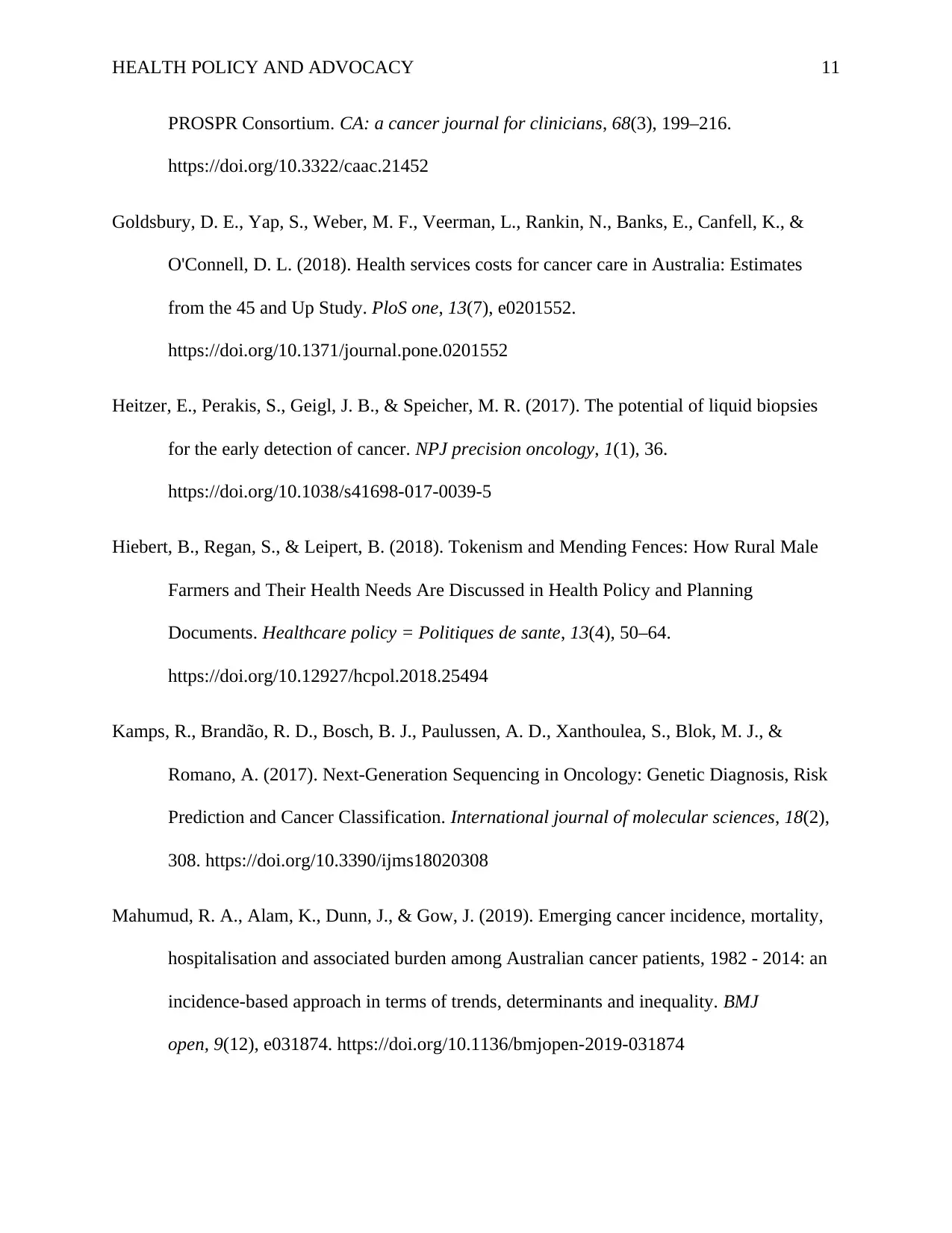
HEALTH POLICY AND ADVOCACY 11
PROSPR Consortium. CA: a cancer journal for clinicians, 68(3), 199–216.
https://doi.org/10.3322/caac.21452
Goldsbury, D. E., Yap, S., Weber, M. F., Veerman, L., Rankin, N., Banks, E., Canfell, K., &
O'Connell, D. L. (2018). Health services costs for cancer care in Australia: Estimates
from the 45 and Up Study. PloS one, 13(7), e0201552.
https://doi.org/10.1371/journal.pone.0201552
Heitzer, E., Perakis, S., Geigl, J. B., & Speicher, M. R. (2017). The potential of liquid biopsies
for the early detection of cancer. NPJ precision oncology, 1(1), 36.
https://doi.org/10.1038/s41698-017-0039-5
Hiebert, B., Regan, S., & Leipert, B. (2018). Tokenism and Mending Fences: How Rural Male
Farmers and Their Health Needs Are Discussed in Health Policy and Planning
Documents. Healthcare policy = Politiques de sante, 13(4), 50–64.
https://doi.org/10.12927/hcpol.2018.25494
Kamps, R., Brandão, R. D., Bosch, B. J., Paulussen, A. D., Xanthoulea, S., Blok, M. J., &
Romano, A. (2017). Next-Generation Sequencing in Oncology: Genetic Diagnosis, Risk
Prediction and Cancer Classification. International journal of molecular sciences, 18(2),
308. https://doi.org/10.3390/ijms18020308
Mahumud, R. A., Alam, K., Dunn, J., & Gow, J. (2019). Emerging cancer incidence, mortality,
hospitalisation and associated burden among Australian cancer patients, 1982 - 2014: an
incidence-based approach in terms of trends, determinants and inequality. BMJ
open, 9(12), e031874. https://doi.org/10.1136/bmjopen-2019-031874
PROSPR Consortium. CA: a cancer journal for clinicians, 68(3), 199–216.
https://doi.org/10.3322/caac.21452
Goldsbury, D. E., Yap, S., Weber, M. F., Veerman, L., Rankin, N., Banks, E., Canfell, K., &
O'Connell, D. L. (2018). Health services costs for cancer care in Australia: Estimates
from the 45 and Up Study. PloS one, 13(7), e0201552.
https://doi.org/10.1371/journal.pone.0201552
Heitzer, E., Perakis, S., Geigl, J. B., & Speicher, M. R. (2017). The potential of liquid biopsies
for the early detection of cancer. NPJ precision oncology, 1(1), 36.
https://doi.org/10.1038/s41698-017-0039-5
Hiebert, B., Regan, S., & Leipert, B. (2018). Tokenism and Mending Fences: How Rural Male
Farmers and Their Health Needs Are Discussed in Health Policy and Planning
Documents. Healthcare policy = Politiques de sante, 13(4), 50–64.
https://doi.org/10.12927/hcpol.2018.25494
Kamps, R., Brandão, R. D., Bosch, B. J., Paulussen, A. D., Xanthoulea, S., Blok, M. J., &
Romano, A. (2017). Next-Generation Sequencing in Oncology: Genetic Diagnosis, Risk
Prediction and Cancer Classification. International journal of molecular sciences, 18(2),
308. https://doi.org/10.3390/ijms18020308
Mahumud, R. A., Alam, K., Dunn, J., & Gow, J. (2019). Emerging cancer incidence, mortality,
hospitalisation and associated burden among Australian cancer patients, 1982 - 2014: an
incidence-based approach in terms of trends, determinants and inequality. BMJ
open, 9(12), e031874. https://doi.org/10.1136/bmjopen-2019-031874
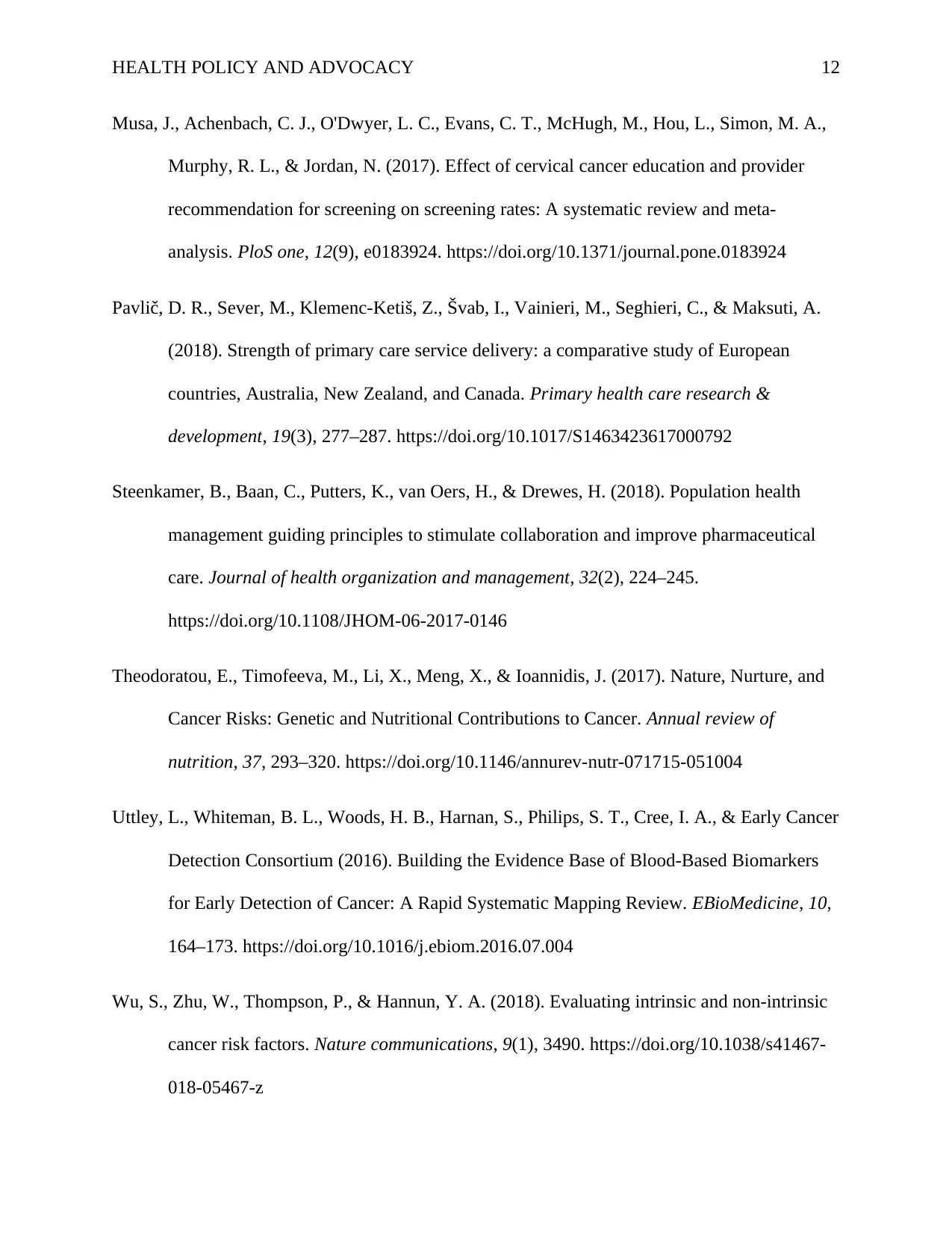
HEALTH POLICY AND ADVOCACY 12
Musa, J., Achenbach, C. J., O'Dwyer, L. C., Evans, C. T., McHugh, M., Hou, L., Simon, M. A.,
Murphy, R. L., & Jordan, N. (2017). Effect of cervical cancer education and provider
recommendation for screening on screening rates: A systematic review and meta-
analysis. PloS one, 12(9), e0183924. https://doi.org/10.1371/journal.pone.0183924
Pavlič, D. R., Sever, M., Klemenc-Ketiš, Z., Švab, I., Vainieri, M., Seghieri, C., & Maksuti, A.
(2018). Strength of primary care service delivery: a comparative study of European
countries, Australia, New Zealand, and Canada. Primary health care research &
development, 19(3), 277–287. https://doi.org/10.1017/S1463423617000792
Steenkamer, B., Baan, C., Putters, K., van Oers, H., & Drewes, H. (2018). Population health
management guiding principles to stimulate collaboration and improve pharmaceutical
care. Journal of health organization and management, 32(2), 224–245.
https://doi.org/10.1108/JHOM-06-2017-0146
Theodoratou, E., Timofeeva, M., Li, X., Meng, X., & Ioannidis, J. (2017). Nature, Nurture, and
Cancer Risks: Genetic and Nutritional Contributions to Cancer. Annual review of
nutrition, 37, 293–320. https://doi.org/10.1146/annurev-nutr-071715-051004
Uttley, L., Whiteman, B. L., Woods, H. B., Harnan, S., Philips, S. T., Cree, I. A., & Early Cancer
Detection Consortium (2016). Building the Evidence Base of Blood-Based Biomarkers
for Early Detection of Cancer: A Rapid Systematic Mapping Review. EBioMedicine, 10,
164–173. https://doi.org/10.1016/j.ebiom.2016.07.004
Wu, S., Zhu, W., Thompson, P., & Hannun, Y. A. (2018). Evaluating intrinsic and non-intrinsic
cancer risk factors. Nature communications, 9(1), 3490. https://doi.org/10.1038/s41467-
018-05467-z
Musa, J., Achenbach, C. J., O'Dwyer, L. C., Evans, C. T., McHugh, M., Hou, L., Simon, M. A.,
Murphy, R. L., & Jordan, N. (2017). Effect of cervical cancer education and provider
recommendation for screening on screening rates: A systematic review and meta-
analysis. PloS one, 12(9), e0183924. https://doi.org/10.1371/journal.pone.0183924
Pavlič, D. R., Sever, M., Klemenc-Ketiš, Z., Švab, I., Vainieri, M., Seghieri, C., & Maksuti, A.
(2018). Strength of primary care service delivery: a comparative study of European
countries, Australia, New Zealand, and Canada. Primary health care research &
development, 19(3), 277–287. https://doi.org/10.1017/S1463423617000792
Steenkamer, B., Baan, C., Putters, K., van Oers, H., & Drewes, H. (2018). Population health
management guiding principles to stimulate collaboration and improve pharmaceutical
care. Journal of health organization and management, 32(2), 224–245.
https://doi.org/10.1108/JHOM-06-2017-0146
Theodoratou, E., Timofeeva, M., Li, X., Meng, X., & Ioannidis, J. (2017). Nature, Nurture, and
Cancer Risks: Genetic and Nutritional Contributions to Cancer. Annual review of
nutrition, 37, 293–320. https://doi.org/10.1146/annurev-nutr-071715-051004
Uttley, L., Whiteman, B. L., Woods, H. B., Harnan, S., Philips, S. T., Cree, I. A., & Early Cancer
Detection Consortium (2016). Building the Evidence Base of Blood-Based Biomarkers
for Early Detection of Cancer: A Rapid Systematic Mapping Review. EBioMedicine, 10,
164–173. https://doi.org/10.1016/j.ebiom.2016.07.004
Wu, S., Zhu, W., Thompson, P., & Hannun, Y. A. (2018). Evaluating intrinsic and non-intrinsic
cancer risk factors. Nature communications, 9(1), 3490. https://doi.org/10.1038/s41467-
018-05467-z
⊘ This is a preview!⊘
Do you want full access?
Subscribe today to unlock all pages.

Trusted by 1+ million students worldwide
1 out of 12
Related Documents
Your All-in-One AI-Powered Toolkit for Academic Success.
+13062052269
info@desklib.com
Available 24*7 on WhatsApp / Email
![[object Object]](/_next/static/media/star-bottom.7253800d.svg)
Unlock your academic potential
Copyright © 2020–2025 A2Z Services. All Rights Reserved. Developed and managed by ZUCOL.





